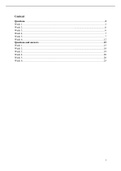Tentamen (uitwerkingen)
Practice Questions (Theory) Statistics 3 Year 3.4 Psychology
- Instelling
- Vrije Universiteit Amsterdam (VU)
This document contains over 70 practice questions covering the theory (no calculations!) of Statistics 3 of the third year of psychology. The questions are open-ended and the answers are explained extensively. All questions are based on the literature and lectures.
[Meer zien]




